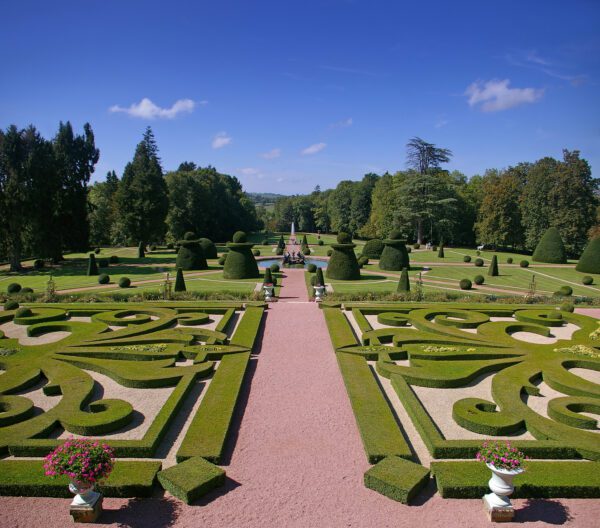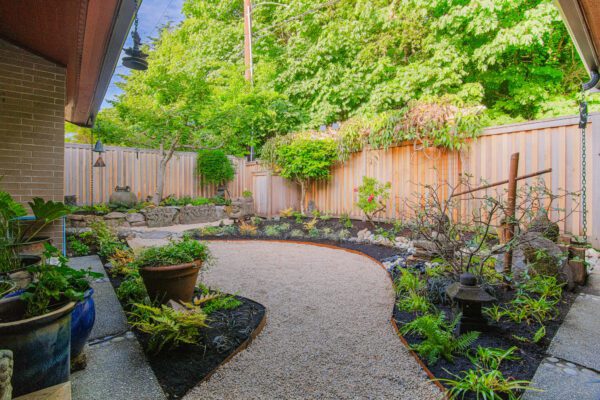Introduction
Landscape design is an essential aspect of creating an aesthetic and functional outdoor space. It involves the arrangement and modification of natural, constructed, and abstract elements in an outdoor area. There are several styles of landscape design, each with its own unique characteristics and features. This article will provide an overview of various landscape design styles.
Formal Gardens
Formal garden design is known for its structured and symmetrical layout. It aims to create a sense of order and elegance in outdoor spaces. In a formal garden, you will often find straight lines, geometric shapes, and well-defined boundaries. The plants and hardscape elements are carefully arranged to create a balanced and harmonious composition. Common features of formal gardens include neatly trimmed hedges, manicured lawns, geometrically shaped flower beds, and classical statues or fountains. The color palette is often restrained, with a focus on shades of green and white. A formal garden design exudes a sense of sophistication and is perfect for those who appreciate a well-organized and refined outdoor space.

Cottage Gardens
A cottage garden is a style of garden design that is known for its informal and romantic charm. It is inspired by the quaint and cozy gardens typically found around traditional English cottages. In a cottage garden, you will find an abundance of colorful and fragrant flowers, often arranged in a seemingly haphazard manner. The plants are usually a mix of perennials, annuals, and biennials, creating a constantly changing and evolving display throughout the seasons. Cottage gardens also often include climbing roses, flowering vines, and cascading plants that add vertical interest to the space. Unlike formal gardens, cottage gardens have a more relaxed and natural feel, with less emphasis on structure and strict boundaries. The color palette in a cottage garden is diverse and vibrant, with a mix of pastel shades and bold hues. Overall, cottage gardens are characterized by their whimsical and inviting atmosphere, making them a popular choice for those who prefer a more casual and romantic outdoor space.

Mediterranean Gardens
A Mediterranean garden is a style of garden design that is inspired by the landscapes and climates of the Mediterranean region, particularly countries like Italy, Greece, and Spain. These gardens emphasize the use of plants that are native to the Mediterranean, such as lavender, rosemary, olive trees, and citrus fruits. The design of a Mediterranean garden aims to create a sense of relaxation and tranquility, often incorporating elements like terracotta pots, stone pathways, and water features like fountains or small ponds. The color palette in a Mediterranean garden is typically warm and earthy, with shades of terracotta, deep greens, and vibrant blues. These gardens often feature a combination of fragrant flowers, aromatic herbs, and ornamental grasses, creating a sensory experience for visitors. With their emphasis on natural materials and a laid-back atmosphere, Mediterranean gardens are a popular choice for those seeking a serene and inviting outdoor space.

Modernist Gardens
A modernist garden is a style of garden design that emerged in the early 20th century and is characterized by its clean lines, minimalistic approach, and emphasis on functionality. This style of garden often incorporates geometric shapes, asymmetry, and a sense of open space. The use of materials such as concrete, steel, and glass is common in modernist gardens, reflecting the industrial aesthetics of the time. Plants are often used sparingly and strategically, with an emphasis on architectural plants and sculptural elements. The color palette in modernist gardens is typically neutral and monochromatic, with pops of bold colors used sparingly for contrast. Overall, modernist gardens aim to create a sleek and contemporary outdoor space that complements the surrounding architecture and provides a sense of simplicity and order.

Japanese Gardens
A Japanese garden is a style of garden design that has its roots in traditional Japanese culture and aesthetics. It is characterized by its tranquil and harmonious atmosphere, with a focus on creating a connection between nature and humans. Japanese gardens often feature elements such as water, rocks, plants, and structures, all carefully arranged to create a sense of balance and serenity. The design principles of a Japanese garden include simplicity, asymmetry, and the use of natural materials. Water is a fundamental element in Japanese gardens, often represented by ponds or streams, and is believed to symbolize purity and tranquility. Rocks are another important feature, representing mountains or islands, and are strategically placed to create a sense of depth and perspective. Plants in Japanese gardens are carefully chosen and pruned to create a harmonious balance between the natural and the man-made. Overall, Japanese gardens aim to provide a peaceful and contemplative space for relaxation and spiritual reflection.

Foliage Gardens
A foliage garden is a type of landscape design that focuses on showcasing a wide variety of plants and foliage. Unlike other types of gardens, which may prioritize flowers or specific features, a foliage garden places emphasis on the colors, textures, and shapes of leaves. It often includes a diverse range of plants with different leaf sizes, colors, and patterns to create visual interest and a vibrant atmosphere. Foliage gardens can feature a mix of evergreen and deciduous plants, offering year-round appeal. The design of a foliage garden aims to create a lush and verdant space that highlights the beauty of leaves and foliage, rather than relying on flowers for visual impact. This type of garden is popular for its low maintenance requirements, as the focus is primarily on the foliage rather than the constant upkeep of flowers. Foliage gardens can be designed in various styles, from formal and structured arrangements to more natural and wild appearances. Regardless of the style, a foliage garden provides an enchanting and visually appealing space for nature lovers and gardening enthusiasts alike.
Productive Gardens
A productive garden is a type of landscape design that prioritizes the cultivation of plants for practical purposes, such as growing fruits, vegetables, herbs, or even medicinal plants. It aims to create a space that is both visually appealing and functional by incorporating elements that support the growth and productivity of these plants. Productive gardens often feature raised beds or containers to optimize space and allow for easier maintenance. In addition, there might be trellises, stakes, or alternative constructions to assist climbing vegetation, along with irrigation systems to guarantee a sufficient water source. In addition to the plants themselves, productive gardens may incorporate compost bins or worm farms to facilitate nutrient-rich soil for optimal plant growth. These gardens provide individuals with the opportunity to grow their own food, reduce their ecological footprint, and connect with nature through the process of cultivation.

Natural Gardens
A natural garden consists of a landscape design that aims to mimic the natural environment and create a space that is harmonious with the surrounding ecosystem. It focuses on using native plants, organic gardening practices, and sustainable materials to create a habitat that attracts and supports local wildlife. Natural gardens often incorporate elements such as wildflowers, grasses, and shrubs that provide food and shelter for birds, butterflies, and other beneficial insects. They may also include features like ponds or rain gardens to promote water conservation and enhance biodiversity. Natural gardens prioritize the use of natural processes and avoid the use of synthetic fertilizers or pesticides, creating a healthier and more sustainable ecosystem. By creating a natural garden, individuals can not only enjoy a beautiful and tranquil outdoor space but also contribute to the conservation of local biodiversity and promote a healthier environment.

Urban Gardens
An urban garden consists of a landscape design that is specifically tailored to fit within an urban environment. It is often characterized by its compact size and the creative use of limited space. Due to the limited availability of land in urban areas, vertical gardening techniques, container gardening, and rooftop gardens are commonly used in urban garden designs. Urban gardens may also incorporate raised beds, trellises, and hanging planters to maximize space utilization. These gardens often focus on growing edible plants, such as vegetables and herbs, as well as ornamental plants to add beauty to the urban landscape. Urban gardens have a vital part to play in encouraging sustainable lifestyles in cities. They offer access to fresh food, enhance air quality, decrease the urban heat island effect, and establish green areas for community involvement and leisure.

Country Gardens
A country garden is a type of landscape design that is inspired by rural or countryside aesthetics. It often features a more relaxed and naturalistic style compared to urban gardens. Country gardens typically incorporate elements such as sprawling lawns, flowering meadows, and native plants. They may also include traditional features like picket fences, stone pathways, and rustic furniture. Country gardens aim to create a peaceful and serene atmosphere, allowing individuals to connect with nature and escape the hustle and bustle of city life. These gardens often showcase a variety of plants, including colorful flowers, shrubs, and trees, to provide a visually appealing and picturesque setting.

Conclusion
In conclusion, exploring different landscape design styles can be a fascinating journey for homeowners. From country gardens with their relaxed and naturalistic appeal to more structured and formal designs, there are numerous options to choose from. However, the best style is ultimately the one that resonates with the homeowner the most. It’s essential to create a landscape that reflects their personal taste and allows them to fully enjoy their outdoor space. Whether it’s the tranquil ambiance of a country garden or the sleek elegance of a modern design, the homeowner’s preferences should take precedence. So, take the time to explore different styles, seek inspiration, and ultimately create a landscape that brings joy and fulfillment to the homeowner.
Want to learn more about Landscape Design, Construction and Maintenance? Get started with these articles!
- Comprehensive List of Landscape Construction Elements
- Discover How a Landscape Designer Can Enhance Your Outdoor Space
- Considerations for Selecting your Landscape Plants in Western Washington
- Exploring Different Landscape Design Styles
Professional Landscaping Services
Investing in a professional landscaping service can make all the difference in the outcome of your landscape project. While it may appear simple to design and build a beautiful and functional outdoor space, it takes significant expertise, effort, and knowledge to create an area that is both aesthetically pleasing and functional. A professional landscaper can take your vision and turn it into a reality, while ensuring that safety standards are met and the final result exceeds your expectations. So if you’re looking to invest in a stunning outdoor space, consider seeking the help of a professional landscaping service. You won’t regret it!